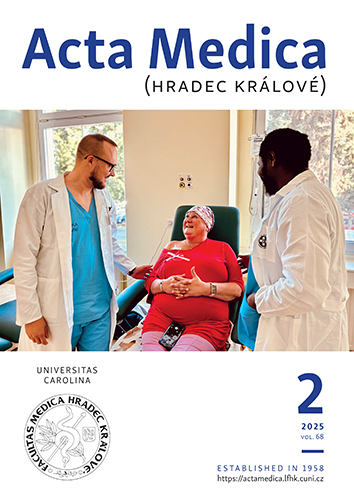ACTA MEDICA, Vol 61 No 4 (2018), 125–130
Epidemiological Profile and Antimicrobial Resistance Pattern of Enteric Fever in a Tertiary Care Hospital of North India – a Seven Year Ambispective Study
Anuradha Makkar, Shilpi Gupta, Inam Danish Khan, Rajiv Mohan Gupta, KS Rajmohan, Harleen Chopra, Manisha Gupta, Sachin Bansal, Bindu Poonia, Muqtadir Malik, Pragyan Swagatika Panda
DOI: https://doi.org/10.14712/18059694.2018.130
published online: 22. 01. 2019
abstract
Introduction: Enteric-fever is a major public-health problem in developing countries emerging as multidrug-resistant, Nalidixic-acid resistant and extremely drug-resistant Salmonella (Pakistan, 2016), has intensified the use of WHO watch/reserve group antimicrobials such as azithromycin and meropenem. Methods: This ambispective-study was conducted on 782 non-repeat blood-culture isolates of S. Typhi, S. Paratyphi A and S. Paratyphi B obtained from 29,184 blood cultures received at a 1000-bedded tertiary-care hospital of North-India from 2011–2017. Identification and antibiograms were obtained by Vitek-2 compact and Kirby-Bauer’s disc diffusion with resistance to ampicillin, chloramphenicol and cotrimoxazole being labeled as multidrug-resistant. Decreased ciprofloxacin-susceptibility and ciprofloxacin-resistance were defined as MIC 0.125–0.5 and >1 μg/ml. Results: S. Typhi and S. Paratyphi A in a ratio of 3.9:1 were seen between July–September predominantly distributed between 6–45 year age group. Resistance to co-trimoxazole, chloramphenicol, ceftriaxone and azithromycin was 6.1%, 13.8%, 16.1 and 5.78% respectively. Multidrug-resistant S. typhi and S. paratyphi A were 2.73% and 1.91% respectively. Conclusion: Enteric-fever is a major public-health problem in India. Emergence of multidrug-resistant, Nalidixic-acid resistant and extremely-drug resistant Salmonella mandates ongoing surveillance for targeted empirical therapy and containment of spread. Repeated epidemics call for water, sanitation, hygiene and vaccination strategies to sustain herd-immunity.
keywords: antimicrobial resistance; enteric fever; multidrug-resistant Salmonella

Epidemiological Profile and Antimicrobial Resistance Pattern of Enteric Fever in a Tertiary Care Hospital of North India – a Seven Year Ambispective Study is licensed under a Creative Commons Attribution 4.0 International License.
210 x 297 mm
periodicity: 4 x per year
print price: 150 czk
ISSN: 1211-4286
E-ISSN: 1805-9694
